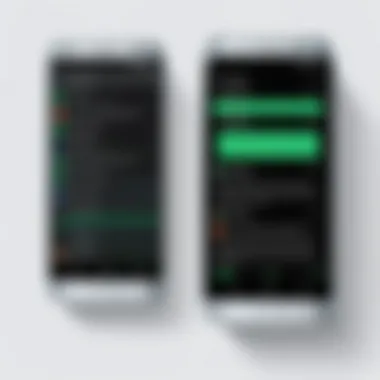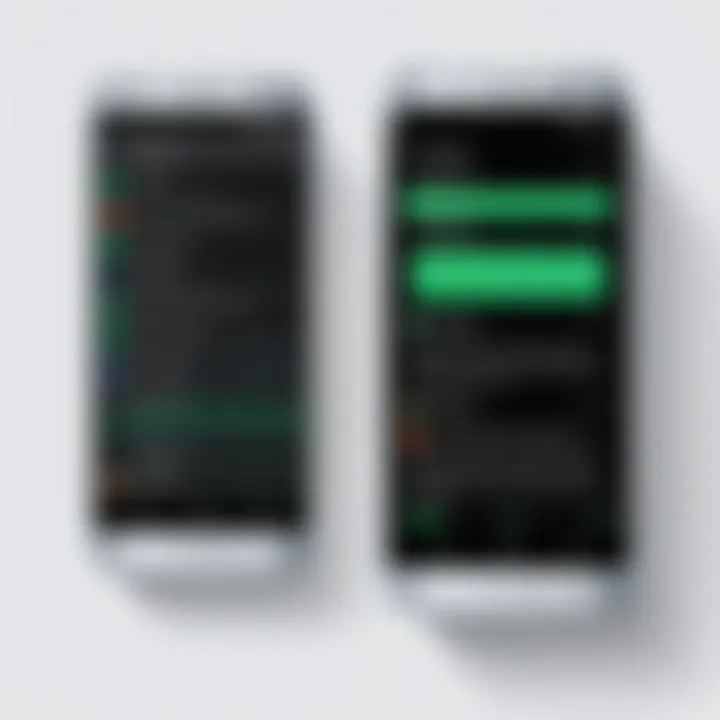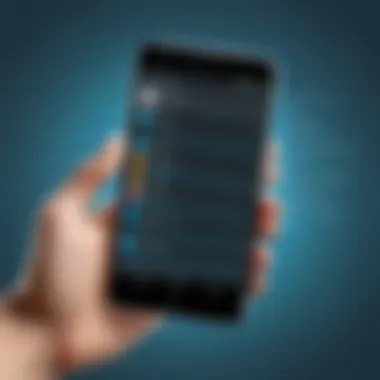Effortless Methods for Transferring Contacts on Android


Intro
Transferring contacts between Android devices is a common task faced by users, especially when upgrading to a new phone or switching between devices. Understanding the methods available helps users not only save time but also ensures important contact information is not lost in the process. This comprehensive guide explores various techniques for transferring contacts, stepping into both manual and automated approaches.
By determining the right method, you can navigate smoothly through data management tasks. This guide targets readers with differing technical skills and preferences. Grasping the details will enhance your overall experience and efficiency with your Android device. Let's delve into the specifics of contact transfer on Android.
Methods of Contact Transfer
Understanding how to transfer contacts involves learning about a few different methods:
- Google Account Synchronization
- SIM Card Transfer
- Third-Party Applications
- Bluetooth Sharing
- File Transfer via USB
Each method holds unique advantages and may appeal to different users based on their requirements.
Google Account Synchronization
Using a Google account is one of the simplest and most efficient ways to transfer contacts. Google effortlessly synchronizes contacts across devices as long as the same Google account is used on each device. To utilize this method, follow the steps:
- On your old device, go to Settings.
- Tap on Accounts.
- Select Google, and enable 'Sync Contacts.'
- Now on your new device, do the same using the same Google account.
Your contacts will now merge onto the new device.
SIM Card Transfer
For users wanting a quick transfer, transferring contacts via SIM card is an option. It’s quite simple:
- Insert your SIM card into the old device if it isn’t in it already.
- Go to the Contacts app, and select the option to export to SIM.
- Remove the SIM card and place it into your new device.
- Open the Contacts app, then select the import SIM feature.
Note that SIMs only support a limited number of contacts.
Third-Party Applications
There are numerous applications available for transferring contacts. Applications like Cut the Rope, Contacts Backup, or My Contacts Backup can assist in the process. Follow the instructions within these apps to facilitate the transfer. They often provide additional features like backup options or cloud storage, affording users flexibility and choice.
Bluetooth Sharing
Sharing contacts via Bluetooth is also a straightforward choice, although a bit slower. Through Bluetooth, you can send individual contacts between devices.
- Firstly, enable Bluetooth on both devices.
- Then, go to the Contacts app, select the contact, and share via Bluetooth for the nearby Android device.
File Transfer via USB
For those who prefer a wired connection, transferring contacts through USB is effective. Use the computer as an intermediary.
- Connect your Android device to your computer via USB.
- Navigate to Internal storage and find the contacts folder.
- Copy this folder to your computer.
- After that, connect your new device and paste those contacts back.
Contact transfer methods are numerous, and your choice will ultimately rely on preference, convenience, or technical comfort. By following the stepped process relevant to each method, you ensure that you can transfer contacts effectively.
Intro
In the realm of modern communication, managing contacts is essential for efficiency and connectivity. As people switch between Android devices, the ability to transfer contacts seamlessly becomes vital. This article sheds light on various methods and considerations in contact transferring.
Understanding how to move personal connections from one device to another can save time and ensure important information is retained.
Moving contacts involves more than just transferring names and numbers. It entails the preservation of essential data associated with each contact, including email addresses and physical addresses. For professionals and individuals alike, missing even a single contact can be detrimental.
The benefits of successful contact transition are numerous:
- Continuity: Retaining connections with colleagues, friends, and family aids in maintaining relationships.
- Efficiency: A streamlined transfer process allows users to get back on track quickly after upgrading devices.
- Minimized Loss: An organized approach to contacts helps eliminate the risk of losing important information.
Before initiating the transfer process, there are several considerations. Assess current device settings, familiarize oneself with the transfer methods, and ensure the necessary backups exist. By adequately preparing, users foster a smoother transition.
Ultimately, this guide serves as a roadmap through various methodologies for contact transfer. With detailed steps and expert insight, adroit handling of contact data is embraced, promoting fuller communication.
The transition process must emphasize preservation of data, emphasizing the ideal methods to adopt.
These facilitatory steps not only enhance user experience, but also lead to educated decision-making throughout the transfer process. By addressing the depth of consideration needed for contact transfer, readers are ensured a firm grip on this critical aspect of modern smartphone usage.
Understanding Contacts on Android
Managing contacts is essential for any mobile user. Android devices allow for a high degree of customization, and thus, understanding contacts becomes vital. Knowing how contacts are organized and stored helps users effectively handle their communication needs. Proper management of contacts can prevent data loss, ensuring that all important information stays intact during device transitions.
Types of Contact Data
Contact data includes various elements that are important for effective communication. Here are some common types of contact data you may encounter:
- Name: The essential identifier for contacts.
- Phone Numbers: Multiple numbers may exist for one contact, including home, work, and mobile.
- Email Addresses: Often, multiple emails can be stored per contact.
- Addresses: Some contacts may also include physical address information.
- Profile Pictures: Visual identifiers that assist with quickly finding contacts in lists.
- Notes: Additional information about a contact that can be useful.


Having a mix of this data provides a richer context for contacts, making communication smoother. This modern view of contacts primarily centers around connectivity. Uniquely identifying profiles can enhance user experience when engaging with coworkers, friends, and family.
Importance of Contact Transfer
Transferring contacts between devices is a common need, especially when upgrading or changing phones. The significance of this process cannot be overstated in today's connected world.
Transferring contacts helps preserve valuable information, particularly number or email addresses critical for work or personal relations. The relevance extends to:
- Continuity: Maintaining the flow of communication without interruptions.
- Time-Saving: Easily transitioning to a new device without needing to manually re-enter details can save significant time.
- Data Integrity: Minimizing the risk of losing important contacts enhances overall data integrity during a transfer.
The efficient management of contacts is not just a convenience; it is an integral part of modern communication practices. Users heavily rely on their contacts for both professional and personal purposes.
Preparing for Contact Transfer
Preparing for contact transfer is an essential step in ensuring seamless movement of your contacts from one Android device to another. If not done correctly, this process can become a source of frustration. Proper preparation helps avoid data loss and minimizes the risks associated with incompatible software versions and file formats. By understanding how to prepare beforehand, you can enhance your overall experience during this transition.
Backing Up Existing Contacts
Taking a backup of existing contacts cannot be overlooked. Accidental deletions or issues during the transfer can lead to valuable data being lost forever. Different Android devices may display contacts linked to various accounts, like Google or local phone storage. Whatever your current method is, ensure you investigate the all-net possibilities.
To back up your contacts effectively:
- Use Google Backup: This option allows you to store contacts within your Google account, making access simple through any Android device.
- Export to VCF: Creating a VCF file of your contacts saves them in a portable format that can easily be imported into another device.
- Local Copies: While less common, storing contacts directly on your computer may be suitable for certain users.
Remember: Always verify backups are completed successfully. Check if all essential contact details are accessible after the backup. This step provides peace of mind during the transfer.
Choosing the Right Method
Selecting the appropriate method for contact transfer depends on individual preferences and technical knowledge. Multiple avenues exist, each with unique advantages and possible drawbacks. Determining the ideal approach is critical to achieving efficient results with minimal complications.
Here are some considerations to keep in mind while deciding on a transfer method:
- Ease of Use: Look for methods with straightforward steps. Not everyone feels comfortable with technical processes. Simpler options can save time.
- Data Integrity and Safety: With some options, like third-party apps or Bluetooth, protecting your data is crucial. Evaluate how safe your data will be during transfer.
- Time Efficiency: Some methods take longer than others. Ensure you balance speed with safety, especially if handling large quantities of contacts.
Finding the best method requires understanding both your comfort level and the features of each option.
Evaluate these elements closely to make an informed decision. Ultimately, whatever method you pick, adequate planning sets a solid foundation for effective contact transfer between devices.
Transferring Contacts via Google Account
Transferring contacts via a Google account is vital in today’s mobile landscape. This method ensures efficiency and accuracy while migrating data. Users benefit largely from seamless integration of contacts over multiple devices. This process not only minimizes the chance of losing important contacts but also saves considerable time compared to other methods.
One decisive advantage of using a Google account lies in its automatic syncing capabilities. Once your contacts are linked to your account, updates reflect across all devices that perform the same account check-in securely.
With Google, you also eliminate the burden of managing large lists manually. Since contacts are stored in the cloud, they are relatively stack and often recoverable, unlike contacts always located on physical devices. Given the persistent Internet access today, this form of transfer provides a reliable and scalable approach.
"Cloud-based contact management systems transform how users organize and transfer their data, resulting in reduced overhead for personal administration."
Syncing Contacts with Google
To sync contacts with a Google account, first, it is crucial to ensure you’ve logged into the correct Google account on your Android device. Here's a straightforward sequence of steps to commence syncing your contacts effectively:
- Open the Settings application on your device.
- Scroll down and select Accounts or Users & Accounts.
- Tap your Google account.
- Choose Account Sync.
- Ensure the toggle next to Contacts is activated.
Once this linkage is executed, your device begins syncing, consolidating contacts stored in your Google account thus prepraing to migrate easily when you move to a new device or update it. This action enables real-time synchroniazation, which means any new contacts created or changes applied automatically update.
Restoring Contacts on New Device
Restoring contacts to your new Android device is almost as easy. The first task is to ensure that you log in to the same Google account used previously. Simply follow these steps:
- Go to Settings on your new device.
- Tap on Accounts or Users & Accounts.
- Add the same Google account if it is not already there.
- Select the account, then go to Account Sync.
- Activate the Contacts sync option.
By enabling contact sync, your device interacts with Google servers to restore any previously saved contacts. This process usually occurs relatively quickly. However, ensure an active Internet connection throughout for dependable syncing.
The Google account method distinguishes itself, offering an efficient route to ensure the security and portability of personal data while maintaining a smooth and user-friendly interface.
Using Third-Party Apps for Transfer
In the current digital landscape, the effective transfer of contact information offers immense importance, particularly for Android users. Utilizing third-party apps for contact transfer can be an efficient alternative to traditional methods. Such applications frequently provide enhanced user interfaces and functionalities that streamline the transfer process, making them attractive for many individuals. Additionally, third-party applications can offer features such as batch processing, customization, and even cross-platform compatibility, which makes them especially useful for users who switch between different operating systems.
Mobile users often face countless options, making the choice of a reliable app critical. Before selecting an application, it’s advisable to consider the reputation of the developer, user reviews, and customer support offerings. Overall, third-party applications present a potential solution that can save time and ensure a seamless experience when transferring contacts.
Recommended Third-Party Applications
When it comes to picking the right third-party app for transferring contacts, several noteworthy options exist:
- My Contacts Backup: This application lets users back up their contacts easily and enables one-tap emailing of contact files in a VCF format.
- Contact Transfer: This app allows users to transfer contacts effortlessly between devices using Bluetooth technology. It is particularly effective for those moving contacts from old to new devices directly.
- Copy My Data: This enables users to simplify transferring contacts between Android devices and even offers options to migrate other types of data.
- ShareIt: Primarily known for transferring files, ShareIt can also efficiently manage contact transfer, with an emphasis on speed and external storage usability.
These applications can simplify the transfer process and reduce the potential for human error during migration.


Step-by-Step Guide to Using the App
To harness the benefits of a selected third-party application, follow this structured guide. While the precise steps may vary based on the chosen app, most will follow a similar pattern.
- Install the App
- Open the App
- Grant Permissions
- Backup Your Contacts (if applicable)
- Choose Transfer Method
- Select Contacts for Transfer
- Execute Transfer
- Access on New Device
- Go to the Google Play Store, search for the selected app such as My Contacts Backup, and tap on 'Install.'
- Once installation is complete, open the application from the app drawer.
- Most contact transfer applications require access to your contacts. Ensure that you grant permissions as requested, so the app can function correctly.
- In apps like My Contacts Backup, there may be an option to back up contacts first. Follow the prompted steps.
- Based on the functions the app offers, identify whether you want to share through Bluetooth, email, or other methods based on instructions.
- You can usually select all contacts or specify certain ones manually, depending on your needs.
- Follow through the final steps like hitting 'Send' in contact-sharing apps or clicking on 'Export' or 'Save.' The methodology should allow completion without complications.
- Finally, make sure to access the new device and check to ensure all desired contacts have been transferred correctly.
Engaging with these applications means extra care is usually needed to follow instructions visioned on the interface. Comprehensive preparation minimizes risks associated with losing critical contact details."
Transferring via Bluetooth
Transferring contacts via Bluetooth is a viable option for Android users looking for a simple, effective, and wireless method of sharing necessary contact information. This method has gained popularity because of its convenience and accessibility. Bluetooth technology allows users to easily share contacts without needing internet connectivity or extra hardware. Although using Bluetooth may not always be the fastest method available, it showcases several advantages worth considering.
Benefits include ease of use, direct device-to-device transfer, and minimal dependency on external apps. Moreover, it avoids potential synchronization issues with cloud services. Recognizing these benefits can help users make informed choices on how to share contacts between their Android devices.
Setting Up Bluetooth Connection
Before transferring contacts via Bluetooth, it is important to ensure that both devices have Bluetooth enabled. To set this up, follow these basic steps:
- Access Your Device's Settings: Open the app drawer, click on the settings icon.
- Locate Bluetooth Menu: Within settings, look for the ‘Connections’ tab or similar option.
- Enable Bluetooth: Toggle the Bluetooth switch to ON position to activate it.
- Make Device Discoverable: Ensure that your device is discoverable by other devices, typically found in the Bluetooth settings.
Make sure the other device can also be discovered and their Bluetooth is turned on. Seeking help from documentation or forums may prove useful if needed. Creating a strong connection ensures that communication between the devices occurs without interruptions, thus enhancing the overall transfer process.
Sending Contacts via Bluetooth
Once both devices are paired, sending contacts is straightforward. Here is how you can accomplish that:
- Open Your Contacts App: Navigate to the contacts app on your device.
- Select Contacts to Share: Choose the specific contact(s) you wish to share. Look for options that allow multi-selections if applicable.
- Select Share Option: After selecting the contacts, tap on the 'Share' option. This often appears as a share icon or straight within a menu.
- Choose Bluetooth from Share Method: A list of sharing applications will appear. Select 'Bluetooth' from this list.
- Select Receiving Device: Choose the name of the device you are sending the contacts to from the list of discoverable devices.
- Confirm the Transfer: On the receiving device, a prompt will ask for confirmation. Approve it to complete the transfer.
By mastering this process, you can quickly share crucial contact information when necessary without direct connections to Wi-Fi or the mobile network.
Using Bluetooth for contact transfer suits environments where data limits exist and services may not be reliable. Overall, while the method may involve practical steps to set up and execute, the features of Bluetooth remain relevant to streamlining information interplay between Android devices.
Importing and Exporting Contacts via VCF Files
Importing and exporting contacts using VCF (Virtual Contact File) files is a vital process for Android users wishing to manage their contacts effectively. This method holds significant importance due to its simplicity, versatility, and capacity to preserve information without the risk of data loss. VCF files contain all valuable contact details, including names, numbers, emails, and addresses. Hence, they serve as a secure means of transferring data between devices.
By using VCF files, users can consolidate and backup their contacts more effortlessly. This approach circumvents potential issues incurred during app-based or Bluetooth transfers, such as incomplete transfers or unwanted duplicate entries. Notably, VCF files are also widely supported across different platforms, adding to the convenience factor.
Attritional efficiency can be reached by methodically managing these files. Both importing and exporting VCF files involve straightforward steps, and optimizing these processes can immensely enhance personal data management skills. Hence, understanding how to create and utilize VCF files is crucial to achieving a seamless contact transfer experience.
Creating VCF Files
Creating VCF files on Android devices is a direct process. Most users looking to export their/contacts can do this in seconds. Here’s a simplified step-by-step of the typical process:
- Open the Contacts app on your Android device.
- Tap on the menu (three vertical dots) and select Export or Manage Contacts.
- Next, generate a VCF file by choosing the relevant contacts you wish to export.
- Save the newly made VCF file to your device storage, cloud, or email for easy access later.
Often, users unwittingly miss crucial contact details, especially when using third-party apps for transfers. These apps might not consistently support VCF format or, in worst situations, may not securely handle the actual contact data.
A VCF file has a universally recognized format. Thus, exporting from one Android device facilitates an easy transition to another or even to non-Android systems. Importantly, when users wish to preserve formatting and existing organization in contacts, VCF offers this vital advantage. It's not merely about transferring contacts; it's about retaining their structure.
Importing VCF Files to New Device
Once you have created and saved the VCF file, the next step is importing that file to a new device. The process involved here shares similar simplicity:
- Transfer the VCF file to the new Android device. This can be done using email, cloud storage, or direct USB connection.
- Open the Contacts app in your Android device.
- Again tap on the menu and select Import or Import/Export Contacts.
- Locate the VCF file and select it to begin the importation.
- Follow any additional prompts until the process finalizes.
The import procedure is selective, meaning users can choose which contacts to restore, minimizing clutter in the new device's contact list. This control aids in avoiding issues such as duplicates, empowering users in managing their contact data effortlessly.
Using VCF files is not just about isolating contacts but centralizes all related information that users might need across devices, enhancing their psychological and more practical experience in data management.
Using SIM Card for Contact Transfer


Using SIM card for contact transfer is a method that remains relevant, especially for users who seek simplicity. This process facilitates easy movement of contacts without internet reliance or complicated setups. Understanding this technique is vital in ensuring smooth data transfer between devices, particularly when considering device environment with limited resources.
Copying Contacts to SIM Card
Copying contacts to a SIM card is a straightforward operation that can significantly simplify moving your information. Before engaging in the transfer, ensure you are aware that SIM cards have limited storage space, usually accommodating up to 250 contacts. Not all contact fields, like emails or addresses, can be stored on the SIM, so prior organization of contact data is prudent.
To copy contacts:
- Access Contacts App: Navigate to your device's Contacts app. On most Androids, this app is integrated into the system.
- Menu Options: Tap the menu icon, usually three lines or dots located on the screen's upper corner.
- Import/Export Option: Look for an 'Import/Export' option or related setting. Select it.
- Copy Contacts: Choose 'Copy to SIM card,' following which you can select contacts to transfer. Be mindful of those that exceed the SIM card's capacity.
Completing these steps will ensure your essential contacts are securely stored on your SIM card.
Transferring SIM Card to New Device
Once contacts are safely copied to the SIM card, transferring it to a new device is simple. Ensure the new phone supports the same SIM card format. When transferring, keep in mind these steps:
- Power Off Both Devices: Ensure your old and new devices are powered off to prevent damage or mishaps during the swap.
- Insert SIM Card: Locate the SIM card slot on the new device. Often, it requires an ejector tool or a small pin.
- Restart Device: Power on the new device after the SIM card insertion. Allow it to recognize the card properly.
- Access Contacts: Open the Contacts app in the new device. Use the import option to bring contacts from your SIM card to the local storage of the new phone.
This straightforward method maximizes content transfer while minimizing the risk of losing valuable information. For backup reasons, maintaining regular copies of your data remains a good practice.
Common Issues During Transfer
When transferring contacts from one Android device to another, users may encounter several challenges. Understanding these common issues enables users to mitigate potential risks effectively. An understanding of these issues minimizes frustration during contact transfer, ensuring that the important data is conserved.
Incomplete Contact Transfer
An often experienced problem is incomplete contact transfer, which occurs when not all contacts transfer successfully. This could result from various factors like device incompatibility, poor network conditions, or errors in the chosen transfer method. The implications include losing essential information, making it crucial to verify the completeness of the transfer.
To prevent such situations, here are some strategies to consider:
- Regular Motions: Always verify and double-check your contacts prior to beginning the transfer. A glance at your existing contact list allows you to identify what is crucial and what needs to be prioritized.
- Proper Backup: Be proactive by backing up contacts before transferring. Use either Google accounts or a third-party application to ensure that there's a fallback in case of incomplete transfer.
- Testing Across Devices: Each device has its interface and behavior regarding contact transfer. Test the method you choose with a smaller batch before proceeding with the full list. This can help fine-tune the process and highlight any platform discrepancies.
Duplicate Contacts
Duplicate contacts tend to generate confusion and clutter within the contact list. In many cases, these duplicates appear following a transfer due to multiple import sources. For instance, using both Google Contacts and a SIM card might lead to similar entries being recorded, resulting in duplicates.
To manage duplicate entries effectively, consider the following actions:
- Use Contact Management Tools: Employ redesigned contact-management applications that come with deduplication features. They can automatically find and merge duplicate entries.
- Manual Review: After the transfer, take time to review your contacts. This allows for a manual check that may expose duplicates that automated solutions may miss.
- Consolidate Information: For any contacts coming from different sources, ensure that valuable information is compiled into one entry. This will not only eliminate duplicates but also create a seamless experience when reaching out to contacts in the future.
Keeping these considerations in mind will significantly enhance the process of transferring contacts between devices and alleviate some of the common challenges.
"Understanding the issues during contact transfer ensures better management of your contact data."
Best Practices for Managing Contacts
Managing contacts is a foundational aspect of using any smartphone, including Android devices. Adopting best practices in this area not only enhances functional efficiency but also ensures that users maintain access to essential information amid the inevitable device transitions.
One crucial benefit of implementing best practices is the organization it brings to one’s contact list. An arranged contact list can streamline communication processes and make it simpler to locate necessary contacts. This efficiency aids in both personal and professional settings, allowing individuals to reach out to the right people without wasting time.
Another vital consideration is the need for regular backups. Technology is often unpredictable; devices can fail without warning. Regular backups prevent significant losses. Users can restore their contact lists promptly, aiding a seamless transition during device changes or unforeseen incidents. Overall, consistent management of contacts reflects a proactive approach that protects important information.
Organizing Contact Lists
Organization of contact lists can be a game-changer for Android users. Start by merging duplicate entries. Manually reviewing and using provided tools can help to identify and consolidate duplicate contacts easily.
Another step is categorization. Divide contacts into groups based on individual needs, such as family, friends, work, or important services. Utilizing the group feature offered on many Android devicess allows users to tailor their communication flows based on varying priorities. Here are some practical suggestions for contact organization:
- Use labeling effectively to ensure that contacts stand out.
- Prioritize frequently used contacts for ***** quicker access****.
- Keep information accurate and up-to-date to avoid any confusion during outreach.
Making these small tweaks can significantly improve the way users navigate their contacts. It directly relates to a more refined communication strategy, acting swiftly in different scenarios.
Regular Backups
Regular backups cannot be overlooked in best practices for contact management. Having a backup ensures that users can retrieve their contacts in any occurring situation. Here are the back-up options utilizing Android devices:
- Cloud Services: Utilize Google Drive or similar services to conduct backups of contacts automatically. Users can access their contact list across different devices at any time.
- Physical Backups: Exporting contacts to a VCF file enables users to have a local copy stored on their computers or external memory. This is especially useful in scenarios where Internet access is not available.
It's important to set reminders for regular backups, ideally doing them monthly or after significant updates to contact information. Following this timetable prevents the loss of creditable contacts. By embedding these simple habits into the routine, users ensure long-term accessibility and functionality of their contact lists.>
Consolidating and safeguarding your contact list is not just a schedule, rather a necessity in avoiding future confusion and loss.
Ending
When transferring contacts between Android devices, choosing the right method is essential. Each transfer process carries its advantages and disadvantages, affecting how easily and accurately your contacts are shifted.
This article outlined different methods for transferring contacts effectively. We explored the use of Google accounts, third-party applications, Bluetooth connections, and VCF files. Understanding these methods allows users to select what feels most comfortable for their needs.
Importantly, retaining key contacts without losing any data matters significantly. Hence, backing up existing contacts before any transfer ensures that you still have access to your contact list should anything go wrong.
Among other key elements discussed, we emphasized the importance of regularly organizing and maintaining your contact lists. It is easy to overlook such tasks until needed the most. Doing so simplifies the efficiency of transferring valuable data from one device to another.
“Simplicity is the ultimate sophistication.” – Leonardo da Vinci
Managing contacts intelligently reflects on personal and professional aspects. Adapt these practices to not only transfer contacts successfully but also enhance the quality of your data management practices.







